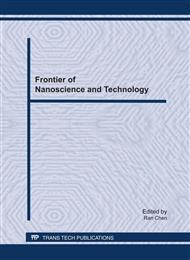p.304
p.309
p.315
p.319
p.324
p.328
p.332
p.337
p.341
Study on the Synthesis and Properties of Nano-ZnO
Abstract:
Nano-ZnO was synthesized by sol-gel method using acetic acid zinc and ammonia as raw material and characterized by XRD, SEM, TEM and N2 adsorption-desorption measurements. In addition, the photoluminescence performance of nano-ZnO was analyzed through PL spectra. The particle size and dispersion degree of nano-ZnO could be controlled by adjusting the addition of surfactant polyethylene glycol-4000. The characterization results revealed that the crystallinity and dispersion degree of nano-ZnO were high and the surface area of nano-ZnO was large, when the amount of polyethylene glycol-4000 was 293.44 mg.
Info:
Periodical:
Pages:
324-327
Citation:
Online since:
July 2011
Authors:
Keywords:
Price:
Сopyright:
© 2011 Trans Tech Publications Ltd. All Rights Reserved
Share:
Citation:


